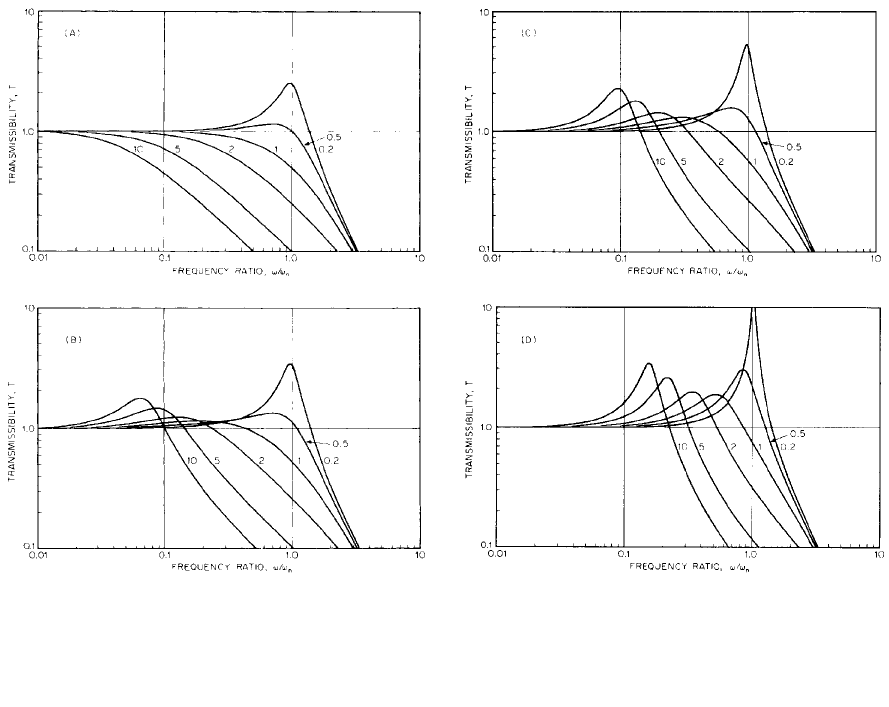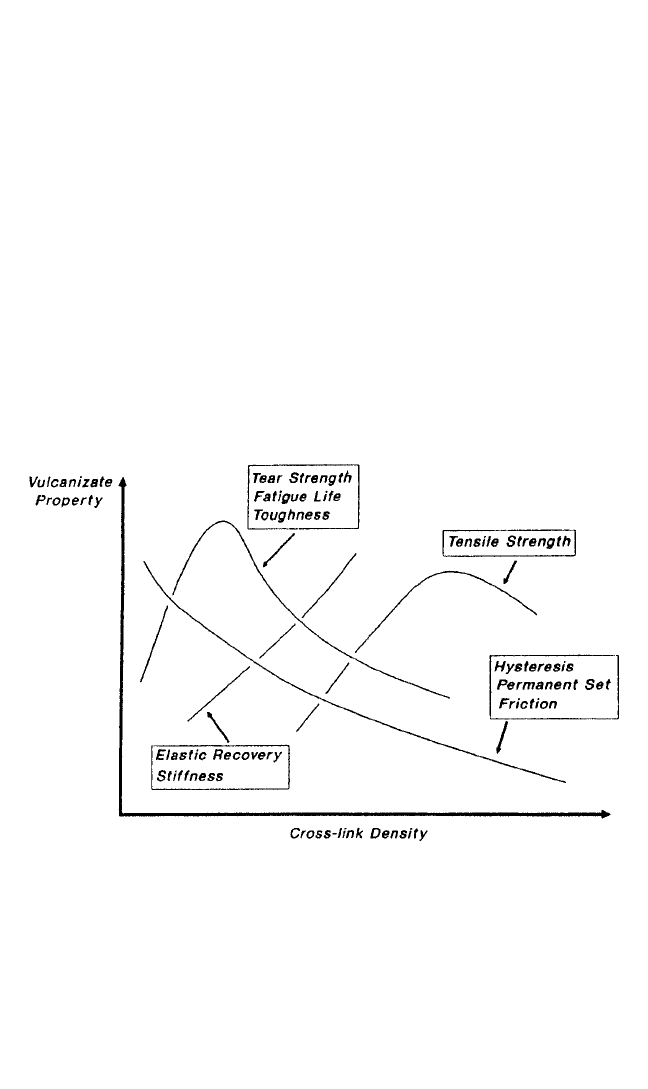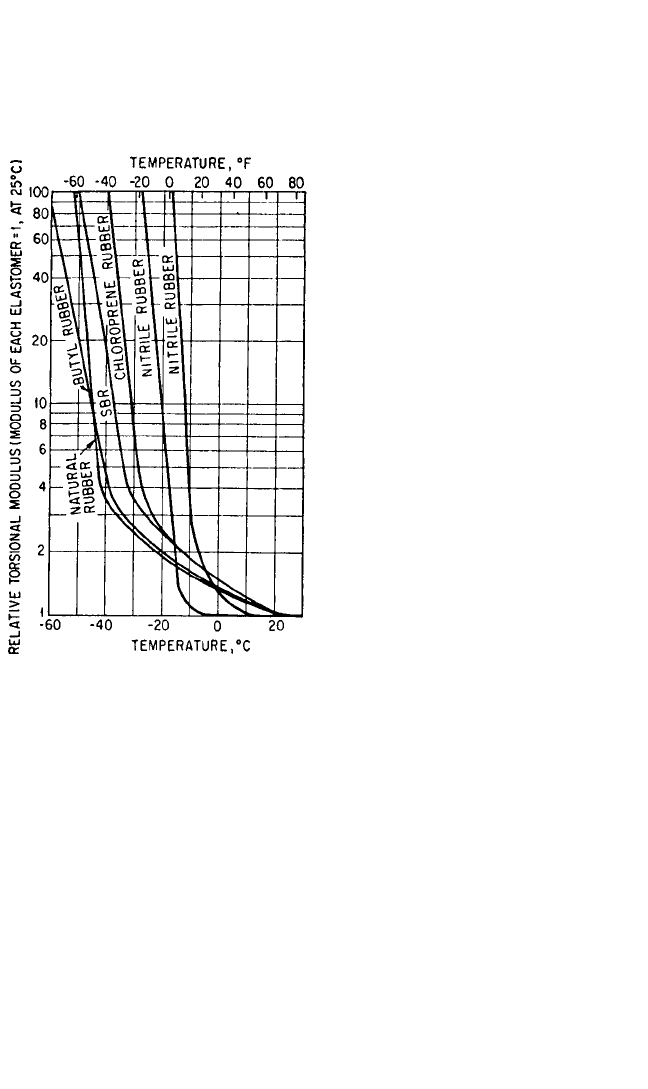Harris C.M., Piersol A.G. Harris Shock and vibration handbook
Подождите немного. Документ загружается.


Steady-State Response. A comparison of the steady-state response of the active
and passive vibration control systems illustrates some of the advantages and disad-
vantages associated with a servo-controlled vibration control system. In Fig. 32.21,
assume that F(t) = 0 and that the vibration excitation is caused by the motion u(t) of
the support base. Then the equation of motion for the supported body of the active
vibration control system having both the active damping servomechanism shown by
Fig. 32.21 and the integral relative displacement control servomechanism shown
by Fig. 32.20 is
m
¨
x + G
2
˙
x + kx + G
1
x dt = ku + G
1
u dt (32.29)
The response of this isolation system, when the vibration excitation u(t) is sinu-
soidal in nature and steady with respect to time, may be expressed in terms of
transmissibility:
T =
(32.30)
Figure 32.23 is a plot of Eq. (32.30) for four values of the relative displacement
dimensionless gain term and six values of the velocity dimensionless gain term,
G
1
/(mω
n
3
) and G
2
/c
c
, respectively. The corresponding expression for the transmissi-
bility for the conventional passive vibration control system differs from that for an
active system, i.e., Eq. (32.30), because of the nature of the force feedback terms act-
ing upon the supported body.At frequencies well above the vibration control system
undamped natural frequency ω
n
, the active and passive system transmissibility equa-
tions differ because of the presence of a damping term in the numerator of the pas-
sive system equation.At these higher frequencies, the passive system transmissibility
has the characteristic that as ω→∞, T → 2(c/c
c
) (ω
n
/ω). The active system, however,
tends to act as an undamped vibration control system wherein the transmissibility at
high frequencies has the characteristic that as ω→∞, T →ω
n
2
/ω
2
. Thus the active
vibration control system provides a lower transmissibility at frequencies above the
system natural frequency, especially for large values of the active and passive damp-
ing terms.
At excitation frequencies close to the system natural frequency, both the active
and passive vibration control systems exhibit a resonance condition when the system
damping terms are small.The peak value of the system transmissibility at the system
resonance frequency is controllable by the addition of damping. In the passive vibra-
tion control system, as the fraction of critical damping is increased, the peak trans-
missibility is lowered, reaching a value of unity for an infinite value of the fraction of
critical damping. Although the passive system damping controls the peak transmis-
sibility, high values of damping greatly degrade the system’s main function of isolat-
ing vibration; in fact, very large magnitudes of the system damping term yield little
to no vibration isolation, since the damper tends to become a rigid link between the
control system vibrating base and the supported body. The effect of damping on the
active vibration control system is similar to that on the passive vibration-isolation
system when the active fraction of critical damping is small. However, as the active
system damping is increased, an increasingly more rigid link is placed between the
supported body and motionless space; thus, increasing the active fraction of critical
damping always decreases the system transmissibility at frequencies above the nat-
ural frequency. With a relative displacement gain G
1
of zero, the active system reso-
nance will disappear when the active fraction of critical damping exceeds unity, as is
shown by the curve of Fig. 32.23A. With an active fraction of critical damping of
unity, the peak transmissibility is also unity and occurs at zero frequency, and for all
(G
1
/mω
n
3
)
2
+ (ω/ω
n
)
2
(ω/ω
n
−ω
3
/ω
n
3
)
2
+ [G
1
/mω
n
3
− 2(G
2
/c
c
)(ω
2
/ω
n
2
)]
2
SHOCK AND VIBRATION ISOLATORS AND ISOLATION SYSTEMS 32.39
8434_Harris_32_b.qxd 09/20/2001 12:32 PM Page 32.39

32.40
FIGURE 32.23 Steady-state frequency response for an active vibration control system having an ideal active damping servomechanism.
The transmissibility is plotted against the frequency ratio ω/ω
n
. In (A) there is no integral relative displacement control servomechanism,
i.e., G
1
/mω
n
3
= 0; in (B), (C), and (D) such a control mechanism has been added and this ratio has values of 0.1,
0.2, and 0.5, respectively.
For each of these illustrations a set of curves is shown for the following values of the ratio
G
2
/C
c
: 0.2, 0.5, 1, 2, 5, and 10. Changes in the ser-
vomechanism feedback constants affect the response characteristics through their dynamic interactions
, which alter the frequency
response at low excitation frequencies.
8434_Harris_32_b.qxd 09/20/2001 12:32 PM Page 32.40

other frequencies the system transmissibility is less than 1, having the approximate
magnitude of 1/[2(G
2
/c
c
) (ω/ω
n
)] at frequencies from zero to about twice the system
natural frequency and ω
n
2
/ω
2
at higher frequencies.
The addition of the relative displacement integral control has little influence on
transmissibility at high frequencies and thus has no important effect on the ability of
the complete system to isolate vibration. However, the effect at lower frequencies is
significant, as is shown in Fig. 32.23B, C, and D. As the dimensionless gain G
1
/mω
n
3
of the displacement control loop is increased, the transmissibility of the system in
the region of resonance increases. If the dimensionless displacement gain term
equals twice the active fraction of critical damping, the active vibration control sys-
tem becomes dynamically unstable. Under these conditions, if the supported body
receives the slightest disturbance, a system oscillation will develop and continue
indefinitely, as would be the case with a passive system without damping. Increasing
the relative displacement gain term above this critical value results in a condition
where the system’s automatic control functions continually add energy to the sup-
ported body and passive spring element in the form of ever-increasing oscillations,
which continue to increase in amplitude until motor saturation or destruction of the
system occurs.
Stability of Active Vibration Control Systems. Operation of a dynamically
unstable active vibration control system exhibits one or more of the following char-
acteristics:
1. The active vibration control system acts like an undamped passive vibration con-
trol system.
2. The system exhibits oscillations that increase with time and can become very
large in magnitude.
3. The system moves to one of its excursion stroke limits and stays there.
The ensurance of a dynamically stable active vibration control system is impor-
tant at both the design and hardware stages of development and can become a com-
plex design task. Much of the field of automatic control system analysis and
synthesis deals with establishing the limits of feedback gains beyond which the sys-
tem becomes unstable.
REFERENCES
1. Racca, R.: “How to Select Power-Train Isolators for Good Performance and Long Service
Life,” Paper 821095, SAE International Off-Highway Meeting and Exposition, Sept. 13–16,
1982.
2. Ushijima, T., K. Takano, and H. Kojima: “High Performance Hydraulic Mount for Improv-
ing Vehical Noise and Vibration,” SAE Paper 880073 International Congress and Exposi-
tion, Detroit, Mich., Feb. 29, 1988.
SHOCK AND VIBRATION ISOLATORS AND ISOLATION SYSTEMS 32.41
8434_Harris_32_b.qxd 09/20/2001 12:32 PM Page 32.41

CHAPTER 33
MECHANICAL PROPERTIES
OF RUBBER
Ronald J. Schaefer
INTRODUCTION
Rubber is a unique material that is both elastic and viscous. Rubber parts can there-
fore function as shock and vibration isolators and/or as dampers. Although the term
rubber is used rather loosely, it usually refers to the compounded and vulcanized
material. In the raw state it is referred to as an elastomer. Vulcanization forms chem-
ical bonds between adjacent elastomer chains and subsequently imparts dimen-
sional stability, strength, and resilience. An unvulcanized rubber lacks structural
integrity and will “flow” over a period of time.
Rubber has a low modulus of elasticity and is capable of sustaining a deformation
of as much as 1000 percent. After such deformation, it quickly and forcibly retracts
to its original dimensions. It is resilient and yet exhibits internal damping. Rubber
can be processed into a variety of shapes and can be adhered to metal inserts or
mounting plates. It can be compounded to have widely varying properties. The load-
deflection curve can be altered by changing its shape. Rubber will not corrode and
normally requires no lubrication.
This chapter provides a summary of rubber compounding and describes the static
and dynamic properties of rubber which are of importance in shock and vibration
isolation applications. It also discusses how these properties are influenced by envi-
ronmental conditions.
RUBBER COMPOUNDING
Typical rubber compound formulations consist of 10 or more ingredients that are
added to improve physical properties, affect vulcanization, prevent long-term dete-
rioration, and improve processability. These ingredients are given in amounts based
on a total of 100 parts of the rubber (parts per hundred of rubber).
33.1
8434_Harris_33_b.qxd 09/20/2001 12:30 PM Page 33.1

ELASTOMERS
Both natural and synthetic elastomers are available for compounding into rubber
products. The American Society for Testing and Materials (ASTM) designation and
composition of some common elastomers are shown in Table 33.1. Some elastomers
such as natural rubber, Neoprene, and butyl rubber have high regularity in their
33.2 CHAPTER THIRTY-THREE
TABLE 33.1 Designation and Composition of Common Elastomers
ASTM designation Common name Chemical composition
NR Natural rubber cis-Polyisoprene
IR Synthetic rubber cis-Polyisoprene
BR Butadiene rubber cis-Polybutadiene
SBR SBR Poly (butadiene-styrene)
IIR Butyl rubber Poly (isobutylene-isoprene)
CIIR Chlorobutyl rubber Chlorinated poly
(isobutylene-isoprene)
BIIR Bromobutyl rubber Brominated poly
(isobutylene-isoprene)
EPM EP rubber Poly (ethylene-propylene)
EPDM EPDM rubber Poly (ethylene-propylene-
diene)
CSM Hypalon Chloro-sulfonyl-polyethylene
CR Neoprene Poly chloroprene
NBR Nitrile rubber Poly (butadiene-acrylonitrile)
HNBR Hydrogenated nitrile rubber Hydrogenated poly
(butadiene-acrylonitrile)
ACM Polyacrylate Poly ethylacrylate
ANM Polyacrylate Poly (ethylacrylate-
acrylonitrile)
T Polysulfide Polysulfides
FKM Fluoroelastomer Poly fluoro compounds
FVMQ Fluorosilicone Fluoro-vinyl polysiloxane
MQ Silicone rubber Poly (dimethylsiloxane)
VMQ Silicone rubber Poly (methylphenyl-siloxane)
PMQ Silicone rubber Poly (oxydimethyl silylene)
PVMQ Silicone rubber Poly (polyoxymethylphenyl-
silylene)
AU Urethane Polyester urethane
EU Urethane Polyether urethane
GPO Polyether Poly (propylene oxide-allyl
glycidyl ether)
CO Epichlorohydrin homopolymer Polyepichlorohydrin
ECO Epichlorohydrin copolymer Poly (epichlorohydrin-ethylene
oxide)
8434_Harris_33_b.qxd 09/20/2001 12:30 PM Page 33.2

backbone structure. They will align and crystallize when a strain is applied, with
resulting high tensile properties. Other elastomers do not strain-crystallize and
require the addition of reinforcing fillers to obtain adequate tensile strength.
1
Natural rubber is widely used in shock and vibration isolators because of its high
resilience (elasticity), high tensile and tear properties, and low cost. Synthetic elas-
tomers have widely varying static and dynamic properties. Compared to natural rub-
ber, some of them have much greater resistance to degradation from heat, oxidation,
and hydrocarbon oils. Some, such as butyl rubber, have very low resilience at room
temperature and are commonly used in applications requiring high vibration damp-
ing. The type of elastomer used depends on the function of the part and the envi-
ronment in which the part is placed. Some synthetic elastomers can function under
conditions that would be extremely hostile to natural rubber.An initial screening of
potential elastomers can be made by determining the upper and lower temperature
limit of the environment that the part will operate under.The elastomer must be sta-
ble at the upper temperature limit and maintain a given hardness at the lower limit.
There is a large increase in hardness when approaching the glass transition tempera-
ture. Below this temperature the elastomer becomes a “glassy” solid that will frac-
ture upon impact.
Further screening can be done by determining the solvents and gases that the
part will be in contact with during normal operation and the dynamic and static
physical properties necessary for adequate performance.
REINFORCEMENT
Elastomers which do not strain-crystallize need reinforcement to obtain adequate
tensile properties. Carbon black is the most widely used material for reinforcement.
The mechanism of the reinforcement is believed to be both chemical and physical in
nature.
2
Its primary properties are surface area and structure. Smaller particle-size
blacks having a higher surface area give a greater reinforcing effect. Increased
surface area gives increased tensile, modulus, hardness, abrasion resistance, tear
strength, and electrical conductivity and decreased resilience and flex-fatigue life.
The same effects are also found with increased levels (parts per hundred rubber) of
carbon black, but peak values occur at different levels. Structure refers to the high-
temperature fusing together of particles into grape-like aggregates during manufac-
ture. Increased structure will increase modulus, hardness, and electrical conductivity
but will have little effect on tensile, abrasion resistance, or tear strength.
ADDITION OF OILS
Oils are used in compounding rubber to maintain a given hardness when increased
levels of carbon black or other fillers are added. They also function as processing
aids and improve the mixing and flow properties (extrudability, etc.).
ANTI-DEGRADENTS
Light, heat, oxygen, and ozone accelerate the chemical degradation of elastomers.
This degradation is in the form of chain scission or chemical cross-linking depending
on the elastomer. Oxidation causes a softening effect in NR, IR, and IIR. In most
other elastomers the oxygen causes cross-linking and the formation of stiffer com-
MECHANICAL PROPERTIES OF RUBBER 33.3
8434_Harris_33_b.qxd 09/20/2001 12:30 PM Page 33.3

pounds. Ozone attack is more severe and leads to surface cracking and eventual
product failure. Cracking does not occur unless the rubber is strained. Elastomers
containing unsaturation in the backbone structure are most vulnerable. Anti-
degradents are added to improve long-term stability and function by different chem-
ical mechanisms. Amines, phenols, and thioesters are the most common types of
antioxidants, while amines and carbamates are typical anti-ozonants. Paraffin waxes
which bloom to the surface of the rubber and form protective layers are also used as
anti-ozonants.
VULCANIZING AGENTS
Vulcanization is the process by which the elastomer molecules become chemically
cross-linked to form three-dimensional structures having dimensional stability. The
effect of vulcanization on compound properties is shown in Fig. 33.1. Sulfur, perox-
ides, resins, and metal oxides are typically used as vulcanizing agents. The use of sul-
fur alone leads to a slow reaction, so accelerators are added to increase the cure rate.
They affect the rate of vulcanization, cross-link structure, and final properties.
3
MIXING
Adequate mixing is necessary to obtain a compound that processes properly, cures
sufficiently, and has the necessary physical properties for end use.
4
The Banbury
internal mixer is commonly used to mix the compound ingredients. It contains two
spiral-shaped rotors that operate in a completely enclosed chamber.A two-step pro-
cedure is generally used to ensure that premature vulcanization does not occur.
33.4 CHAPTER THIRTY-THREE
FIGURE 33.1 Vulcanizate properties as a function of the extent of vulcanization. (Eirich
and Coran.
3
)
8434_Harris_33_b.qxd 09/20/2001 12:30 PM Page 33.4

Most of the ingredients are mixed at about 120°C in the first step. The vulcanizing
agents are added at a lower temperature in the second step.
MOLDING
Compression, transfer, and injection-molding techniques are used to shape the final
product. Once in the mold, the rubber compound is vulcanized at temperatures
ranging from 100 to 200°C. The cure time and the temperature are determined
beforehand with a curemeter, such as the oscillating disk rheometer.
5
After removal
from the mold, the rubber product is sometimes postcured in an autoclave. The
postcuring gives improved compression-set properties.
STATIC PHYSICAL PROPERTIES
Rubber has properties that are drastically different from other engineering materi-
als. Consequently, it has physical testing procedures that are unique.
6
Rubber has
both elastic and viscous properties. Which of these properties predominates fre-
quently depends on the testing conditions. A summary of the characteristic proper-
ties of different elastomers is shown in Table 33.2.
HARDNESS
Hardness is defined as the resistance to indentation. The durometer is an instrument
that measures the penetration of a stress-loaded metal sphere into the rubber. Hard-
ness measurements in rubber are expressed in Shore A or Shore D units according
to ASTM test procedures.
7
Because of the viscoelastic nature of rubber, a durome-
ter reading reaches a maximum value as soon as the metal sphere reaches maximum
penetration into the specimen and then decreases the next 5 to 15 sec. Hand-held
spring-loaded durometers are commonly used but are very subject to operator error.
Bench-top dead-weight-loaded instruments reduce the error to a minimum.
8
STRESS-STRAIN
Rubber is essentially an incompressible substance that deflects by changing shape
rather than changing volume. It has a Poisson’s ratio of approximately 0.5. At very
low strains, the ratio of the resulting stress to the applied strain is a constant
(Young’s modulus).This value is the same whether the strain is applied in tension or
compression. Hooke’s law is therefore valid within this proportionality limit. How-
ever, as the strain increases, this linearity ceases, and Hooke’s law is no longer appli-
cable. Also the compression and tension stresses are then different.This is evident in
load-deflection curves run on identical samples in compression, shear, torsion, ten-
sion, and buckling, as shown in Fig. 32.2. Rubber isolators and dampers are typically
designed to utilize a combination of these loadings. However, shear loading is most
preferred since it provides an almost linear spring constant up to strains of about 200
percent. This linearity is constant with frequency for both small and large dynamic
shear strains.The compression loading exhibits a nonlinear hardening at strains over
30 percent and is used where motion limiting is required. However, it is not recom-
MECHANICAL PROPERTIES OF RUBBER 33.5
8434_Harris_33_b.qxd 09/20/2001 12:30 PM Page 33.5

TABLE 33.2 Relative Properties of Various Elastomers
VMQ
MQ,
IIR EPM ACM PMQ, AU CO
ASTM designation NR BR SBR CIIR EPDM CSM CR NBR HNBR ANM T FKM FVMQ PVMQ EU GPO ECO
Durometer range 30–90 40–90 40–80 40–90 40–90 45–100 30–95 40–95 35–95 40–90 40–85 60–90 40–80 30–90 35–100 40–90 40–90
Tensile max, psi 4500 3000 3500 3000 2500 4000 4000 4000 4500 2500 1500 3000 1500 1500 5000 3000 2500
Elongation max., % 650 650 600 850 600 500 600 650 650 450 450 300 400 900 750 600 350
Compression set A B B B B-A C-B B B B-A B D B-A C-B B-A D B-A B-A
Creep A B B B C-B C B B B C D B B C-A C-A B B
Resilience High High Med. Low Med. Low High Med.-Low Med. Med. Low Low Low High-Low High-Low High Med.-Low
Abrasion resistance A A A C B A A A A C-B D B D B A B C-B
Tear resistance A B C B C B B B B D-C D B D C-B A A C-A
Heat aging at 212°F C-B C B A B-A B-A B B A A C-B A A A B B-A B-A
T
g
, °C −73 −102 −62 −73 −65 −17 −43 −26 −32 −24, −54 −59 −23 −69 −127, −86 −23, −34 −67 −25, −46
Weather resistance D-B D D A A A B D A A B A A A A A B
Oxidation resistance B B C A A A A B A A B A A A B B B
Ozone resistance NR-C NR NR A A A A C A B A A A A A A A
Solvent resistance
Water A A B-A A A B B B-A A D B A A A C-B C-B B
Ketones B B B A B-A B C D D D A NR D B-C D C-D C-D
Chlorohydrocarbons NR NR NR NR NR D D C C B C-A A B-A NR C-B A-D A-B
Kerosene NR NR NR NR NR B B A A A A A A D-C B A-C A
Benzol NR NR NR NR NR C-D C-D B B C-B C-B A B-A NR C-B NR B-A
Alcohols B-A B B B-A B-A A A C-B C-B D B C-A C-B C-B B C A
Water glycol B-A B-A B B-A A B B B A C-B A A A A C-B B C
Lubricating oils NR NR NR NR NR A-B B-C A A A A A A B-C A-B D A
A = excellent, B = good, C = fair, D = use with caution, NR = not recommended
SOURCE: Seals Eastern, Inc.
33.6
8434_Harris_33_b.qxd 09/20/2001 12:30 PM Page 33.6

mended where energy storage is required. Tension-loading stores energy more effi-
ciently than either compression-loading or shear-loading but is not recommended
because of the resulting stress loads
on the rubber-to-metal bond, which
may cause premature failure. Buckled-
loading is a combination of tension- and
compression-loading and derives some
of the benefits of both.
The stress-strain properties of rub-
ber compounds are usually measured
under tension as per ASTM proce-
dures.
9
Either molded rings or die-cut
“dumbbell”-shaped specimens are used
in testing. Stress measurements are
made at a specified percentage of elon-
gation and reported as modulus values.
For example, 300 percent modulus is
defined as the stress per unit cross-
sectional area (in psi or MPa units) at
an elongation of 300 percent. Also
measured are the stress at failure (ten-
sile) and maximum percentage elonga-
tion. These are the most frequently
reported physical properties of rubber
compounds.
The stiffness (spring rate) is the ratio
of stress to strain expressed in newtons
per millimeter. It is dependent not only
on the rubber’s modulus but also on the
shape of the specimen or part being
tested. Since rubber is incompressible,
compression in one direction results in
extension in the other two directions,
the effect of which is a bulging of the
free sides. The shape factor is calculated
by dividing one loaded area by the total
free area.
TEAR
Vibration isolators and dampers that are subjected to cyclical loads frequently fail
due to a fracturing of the rubber component. A fracture may initiate in an area
where stress concentration is at a maximum. After initiation, the fracture increases
in size and progresses into a tearing action. Tear properties are therefore important
in some applications. Tensile tests are run on dumbbell-shaped samples containing
no flaws. The stress is therefore evenly distributed across the sample. Tear-testing
procedures concentrate the stress in one area, either through sample design or by
cutting a nick in the sample.
10
Samples are die cut (die A, B, or C) from tensile test-
ing sheets. The peak force and sample thickness are recorded. Tear values are
reported in units of pounds per inch or kilonewtons per meter.Tear and tensile test-
ing provide the same rank ordering of different types of rubbers.
MECHANICAL PROPERTIES OF RUBBER 33.7
FIGURE 33.2 Increase in torsional modulus
of elasticity of various elastomers as a function
of temperature. (After Gehman.
16
)
8434_Harris_33_b.qxd 09/20/2001 12:30 PM Page 33.7
